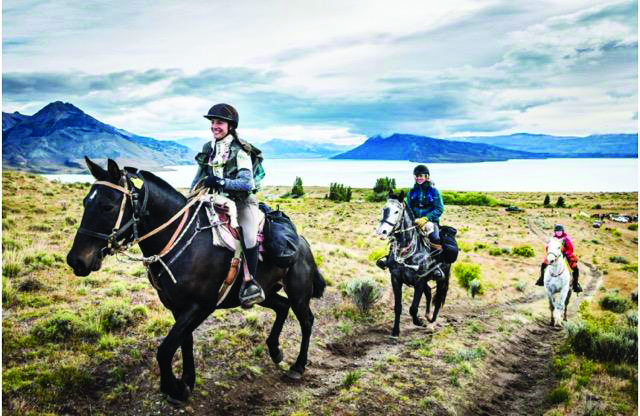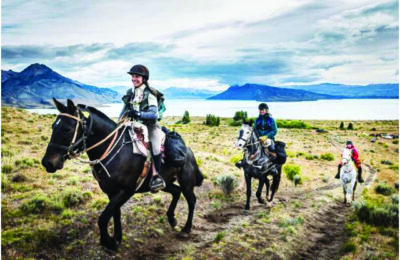
By Robin Sias

When Julie Youngblood committed to being one of the ‘pioneers’ in the first Gaucho Derby, a race billed as the “greatest test of horsemanship and survival skills on earth,” spanning two weeks and 500 kilometers through the most rugged and sublime country in Patagonia, she knew it would be the kind of experience that defines the word ‘adventure.’ After all, Julie had previously prevailed in the Mongol Derby, a similar, though slightly less challenging, endurance race in 2012, sponsored by the same folks behind the Gaucho Derby.
She prepared and trained diligently for six months before setting out on March 5 with her lifelong friend and partner in the race, open to what the next weeks might bring. Julie, her friend Sophie, and the 22 other riders from South Africa, Canada, Hungary, Thailand, and the U.K., among other far-flung locations, along with 56 horses, lined up at the start, ready to test their horsemanship and wilderness skills. But it was going to be a leap of faith.
“They didn’t give us much information before we got there for a three-day start camp,” Julie explained. “In fact, they left it pretty vague and that was partially because we were the first group to do this race—the pioneers, they called us. We were going to help invent it. They didn’t release the course until we got there.”
During the start camp, Julie also learned just how bare-bones the experience would be.
“We learned that we were going to do each stage with only one horse and sometimes a pack horse,” Julie said. “We didn’t know what animal we were riding until we met them. We were given a base saddle and learned how Argentinians approach horsemanship. Getting a glimpse at the beautiful culture not many people get to see was an amazing experience. And the horses were wonderful creatures—the ultimate four-wheel-drive of horses!”
The directions given to the racers were pretty minimal, too.
Julie explained, “We were all given the same GPS coordinates for checkpoints and topo maps. We were allowed less than 20 pounds of gear, including clothes, food, tent, and personal medical and rescue equipment. There were some checkpoints at ranches that offered food, but many stretches were two to three days in between checkpoints. I was really thankful for my experience riding in the high alpine. I knew how much food to bring, and I knew that mountain weather is dramatic and changes quickly. I felt pretty well prepared.”
As Julie and Sophie set out that first day, her experience and preparedness made all the difference. They began their ride in 80-degree weather in the high desert, but by day three, they were riding in 20-degree weather and into an epic snowstorm that hit at about 9,000 feet.
“The second to the fourth nights were a blizzard,” Julie said.
Due to a series of incidents near the start of the race (think a horse that bucked Julie off and require she circle back to the start and delay her progress), she got to one of the vet checks on the course at a high alpine lake when the storm hit, which turned out to be a great place to ride out the bad weather.
“We were able to find shelter for us and the horses and kept a fire going through the night. We were with some of the other riders, so among us we had enough food and we were okay,” she remembered.
Others in the race were not so lucky. “Other people who were outside in the storm had to be life-flighted back to the closest city to be treated for hypothermia and even more serious issues,” she said.
At that particular juncture, and throughout the race, Julie appreciated all her EMT and backcountry rescue training as a full-time member of the Sun Valley Fire Department. She was also grateful for Sophie, who she calls a “consummate mountain gal.” Once the weather lifted, they continued on their way, bonded for life with the riders they sheltered with and grateful for their incomparable horses.
Julie said she likes to be on horseback more than just about anywhere else. She first fell in love with riding when she and her twin sister, in response to endless begging, were given a pony to share when they were about 10 years old. Growing up in Los Angeles, riding soon became a major part of her life.
Julie went on to ride competitively in high school, with Hunter Jumper as her favorite event. She continued to compete while an undergraduate at NYU and even served as captain of their equestrian team. Like so many, after college Julie moved to Sun Valley to ski for ‘one season,’ and stayed, holding what she calls “every job under the sun,” from river raft guide, to ski instructor, and finally to firefighter. She never gave up her horsemanship.
Despite the hardships of the race, the highlights of the experience are what Julie said will stay with her forever. “There were so many moments of unbridled joy,” she said. “Sophie and I decided we would live every moment, embrace every moment. At night, we drank Malbec and hung out with the gauchos before getting just a few hours of sleep and heading out again. We made friends for life.
“The best part about the whole thing was starting the race with strangers and quickly banding together in this survivalist setting. By the end of the snowstorm that first week, it was no longer a race. It was a group experience to get people through in one piece and enjoy the experience as much as possible.”
Getting to the finish line was an emotional moment for Julie.
“On that last day, when we crossed the highest point of the ride, we were surrounded by the iconic mountain ranges of Patagonia—a place you can access only by foot or horseback,” she said. “To get to the actual finish line we had to swim the horses across a huge river. I could see my parents waiting on the other side. It’s something I will never forget.”
The reality waiting on the other side as Julie found as she forded that final river, though, was a world that had changed forever during her time in the mountains. While she was testing her survival skills in the wilderness, the COVID-19 pandemic began to sweep across every continent, something Julie was completely unaware of.
“When I saw my parents, they had our plane tickets in hand, ready to leave the next morning,” she recalled. “It was so bizarre and it definitely made the celebration at the end of the race a different experience. Everyone was suddenly scrambling to try to make plans to get home.”
That was mid-March and the window to return to Idaho was closing fast.
“Going through airports when everyone was freaking out was strange,” she said, but she successfully made her way back through Buenos Aires, Texas, and L.A. before finally driving back to the Wood River Valley.
Instead of celebrating with friends upon her return, Julie went straight into 14 days of quarantine. She marvels a bit at the timing of the race and the fact that, after all her training and preparation, she was able to have that experience, even in these uncertain times.
The memories of her time in the Patagonia high country, with her best friend, new friends, beautiful horses, and jaw-dropping scenery, got her through her quarantine and are ones she will cherish for the rest of her life.
For 2020, Team Julie and Sophie ended up technically finishing this ultra endurance challenge in 12th place, but for the adventurers, it was much more about the journey than the outcome. And yes, COVID permitting, she hopes to go back and be part of the crew next year.


